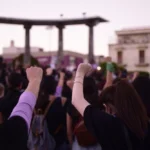Published August 13, 2021
One of modern feminism’s central tenets – abortion as empowerment – symbolizes failure rather than progress in the women’s movement, author Erika Bachiochi suggests in a new book.
Titled “The Rights of Women: Reclaiming a Lost Vision,” the book portrays women as increasingly disadvantaged by principles that became prominent in the 20th century’s conception of liberty. Rather than merely liberating, she argues, the industrial and sexual revolutions have disrupted longstanding dynamics that allow the sexes to pursue authentic freedom; that is, the freedom to pursue virtue in familial and social relationships.
#MeToo, Harvey Weinstein and the objectifying influence of rampant pornography are all evidence to Bachiochi that feminists, while thinking they’re equalizing power, have encouraged some of the worst aspects of male exploitation.
Men, not women, she suggests, are the true beneficiaries of dismantling sexual norms. And ignoring the very real differences between the two has handicapped women’s flourishing in an increasingly male world.
Below is an interview between Fox News and Bachiochi, who is a fellow at the Ethics and Public Policy Center (links are hers).
You depict modern feminism’s idea of freedom as conflicting with what its early proponents imagined. And at the end of one of your chapters, you say: “let us conclude by reimagining feminism anew: a feminism in search of human excellence.” Can you elaborate on that?
Today we tend to think of freedom as its own end, relishing most especially our autonomy, our “right to choose.” And so, any constraints on our choices and the fulfillment of our desires (whatever they may be) are the great obstacles to our freedom. Modern feminism is perhaps most associated with this manner of thinking and so has done much damage in promoting it.
By contrast, mid-19th century women’s rights advocates, following late-18th century British philosopher Mary Wollstonecraft, understood that to be truly independent and free, our choices ought to be governed not by our desires (or fears) but by the highest principle within us: reason.
But reason is not disembodied raw logic, as it’s often reductively conceived of today. As anyone who appeals to fairness or justice (from a young child to MLK) implicitly recognizes, reason makes commands on human conduct, bidding us to do good and avoid evil. The content of what is good and what is evil is often difficult to discern in the details, but we can say with confidence that we recognize the good when see it: for instance, when the vulnerable are protected, an honest account is given against personal advantage, or patience and courage are displayed in the face of difficulty. Each of these acts requires of us a kind of self-mastery, the capacity to step back from and orient our desires in accord with what is actually good; in a word, to inquire whether a particular course of action is choice-worthy.
To live according to the dictates of our desires is to live as a mere animal. But to strive to live excellently, or virtuously, is to live in accord with our high dignity as human beings. And that is to be truly free. As Wollstonecraft famously put it: “Society can only be happy and free in proportion as it is virtuous.”
How have those visions of freedom led to different views of abortion?
When freedom is simply understood as removing obstacles to whatever one is pursuing, ridding oneself of an unexpected pregnancy would seem to be in accord with it. Such an account of freedom also countenances no restraints on sexual desire: as long as the parties consent, desire should dictate behavior.
But Wollstonecraft and her 19th century successors were deeply attentive to the asymmetrical realities of sexual intercourse and so sought to bring sexual norms in line with those realities. After all, the reproductive differences between men and women include some really significant asymmetries, the first of which is the most obvious: it is women, but not men, who can get pregnant. But we also now know through science what these early women’s rights advocates intuited from life experience: there are hormonally driven asymmetries in sexual desire (i.e, testosterone) and sexual (and maternal) attachment (i.e., estrogen) too. All of these asymmetries make modern feminism’s embrace of our culture’s casual sex ethic a deeply male-oriented affair. By contrast, the earliest women’s rights advocates sought a thoroughly pro-woman approach.
Understanding the myriad ways sex impacts women far more than men — and recognizing abortion as the illegitimate act of violence that it is — Wollstonecraft and her successors denounced instead “the want of male chastity,” calling men with women to attend to the “noble purpose” and “parental design” of sex (again, Wollstonecraft). They therefore practiced what they called “voluntary motherhood,” believing that when pregnancy was not desired, sexual abstinence would be the best means to both harmonize and equalize the asymmetries of sex and meanwhile instill moderating habits of self-mastery and intimate regard for the other.
With rampant porn use and sex trafficking, and #MeToo victims around every corner it seems, modern feminism’s embrace of the promises of the sexual revolution has been a clear failure. For the good of women – and men and children too — it’s time to reclaim the noble vision of our country’s earlier women’s movement.
The book seems to identify Elizabeth Cady Stanton and the industrial revolution as major sources of ideological change within feminism. How do you think Stanton’s conception of rights has prevailed over Wollstonecraft’s and others’?
Stanton is a pivotal figure because while she and her peers in the early women’s rights movement agreed on many issues, Stanton tended to offer a rational more in keeping with the liberal philosophy of John Locke and John Stuart Mill than with contemporaries like Sarah Grimké, who followed Wollstonecraft instead.
Whereas Wollstonecraft and Grimké regarded human beings as fundamentally relational and constituted, in large part, by their duties as daughters, sons, husbands, wives, mothers and fathers, Stanton saw these relations as “incidental,” with individuality more primary. So while Wollstonecraft saw that civil and political rights were properly grounded in obligations to God, self and others, Stanton sought rights on the basis of the individual’s self-ownership and self-sovereignty. And as it turns out, this individualistic argument, when it came to women’s suffrage, was not the one that won the day.
But as modern images of human beings as autonomous individuals gained cultural currency, Stanton’s then-radical Millian view of marriage as akin to a business partnership at will became the view of 1970s feminists. And though she regarded abortion as a great moral evil, her choice Lockean rhetoric rightly defending women’s sovereignty over their own bodies was transformed by abortion advocates into doing what one willed with the body of another.
You suggest that abortion effectively capitulates to a dehumanizing logic found in late-stage capitalism. What do you say to women who argue there’s no alternative and that effective feminism can only attain equality by adapting to the realities of the market?
I say let’s band together against this logic and demand that employers and other public actors bend to the realities of both human life and the human family. The benefits of a market economy – and they are manifold – cannot be sustained without flourishing families. Human beings need work to flourish, and they need remunerative work to provide for themselves and their families. Markets should be free to generate well-paying, honest work. But adults – and the children and other dependents in their care – need far more than paid work, and they need the time to engage in the character-shaping, solidarity-building work that should take place in the home perhaps most of all.
In order to restore value to childbearing, you suggest employers account for a “care advantage” in determining mothers’ transferrable skills. Can you explain more what this is? Do you worry that it might fall short by trying to act within the same frame of utilitarian capitalism — by making it tangible, potentially quantifiable, and something to be measured against other market values?
It’s a significant data point that when women seek to return to work after caring for children for even a short time, their labor market absence is more greatly penalized by prospective employers than had they simply been unemployed. (The same is true of men who do so, but they engage in dedicated care work far less frequently than women do.) And workplace discrimination against pregnant women, mothers and other caregivers is still pervasive, and of course, negatively impacts single and poor mothers the most.
Because parenthood is so often conceived of today as a “lifestyle choice” rather than as culturally essential work that mothers and fathers are doing for us all, employers can neglect to see the myriad ways in which engagement in family life shapes mothers and fathers for the better. I’m not sure recognizing this “care advantage” would need to be “quantified” in any way by employers. But it certainly would be better appreciated if nurturing and forming human beings for mature adulthood was understood as the crucial work that it is.
You indicate there isn’t perfect equality because of inherent differences between the sexes. Do you think it’s possible to use market-based tools or policies in order to manifest the type of equality you think exists between them?
As I mentioned earlier, reproductive difference gives rise to sexual asymmetries (or as you say, inequalities). 1970s feminism sought to equalize these asymmetries through widespread contraception and easy access to abortion – taking the male body and its capacity to walk away from the consequences of sex as normative. But the early women’s rights advocates proposed a very different response to such asymmetries: since nature has both gifted and burdened women with the capacity to bear children, law and culture ought to both gift and burden men with the duties that come with begetting them. And that means promoting and honoring a deeply engaged fatherhood should become a – if not the – cultural priority.
I think all of this this is primarily the work of culture, but many of our laws and policies are shaped around the false idea that the human person is an individual unencumbered by any natural duties to others (or any dependencies upon others). And so workplace and government policy can do a far better job in seeing human beings as they really are (or should be): members of families and communities within which they have identity-constituting duties of care.
Many seem to see the prevailing version of feminism as widespread and insurmountable. What do you think are some policies or cultural movements that might prompt a return to older ideas about freedom and feminism?
I honestly think that Roe v. Wade and Planned Parenthood v. Casey are the prime obstacles to reshaping how we think about vulnerability, caregiving and the shared responsibilities of men and women. Overturn those and one hopes we can begin to see pro-life feminism take root.
There was and still is a lot of debate over whether women should be defined in reference to their reproductive capabilities. How do you think the law should view “woman” as a gender? What is the best way to ensure their biological capabilities are honored while not reducing women to those capabilities themselves?
The easiest answer to your question is that it is far better to view woman (and man) legally as a sex, not a “gender,” with all the implications that term now has. We cannot truly honor the remarkable capacity women have to nurture human beings within them if we think men (who definitionally lack this capacity) can simply become women by dressing in stereotypically feminine garb, taking female hormones, or even having themselves castrated. But of course women are not reducible to their sexed bodies, and neither are men.
My book is a lengthy response to this complex question but put as simply as I can: women and men share a rational nature that is ordered to what is good and true (or as Wollstonecraft put it, virtue and wisdom). The goal for human beings is to integrate, through living the virtues, the distinctive bodily capacities that we share with the animals — so we do not live as though we are merely animals.
Wollstonecraft worked in the late 18th century to convince her contemporaries that women were not sexual playthings or animals for breeding, but were, like men, “rational creatures” – full human beings responsible to God and others. Today, her vision of what it means to be fully human is one we all might better heed. We human beings are our bodies but we are not merely our bodies. We are created with freedom to live according to that which is most excellent in us.
Erika Bachiochi is a fellow at the Ethics and Public Policy Center and the author of The Rights of Women: Reclaiming a Lost Vision.
Sam Dorman is a reporter with Fox News.
EPPC Fellow Erika Bachiochi is a legal scholar specializing in Equal Protection jurisprudence, feminist legal theory, Catholic social teaching, and sexual ethics. She is also a Senior Fellow at the Abigail Adams Institute in Cambridge, MA, where she founded and directs the Wollstonecraft Project. Her newest book, The Rights of Women: Reclaiming a Lost Vision, was published by Notre Dame University Press in 2021.








